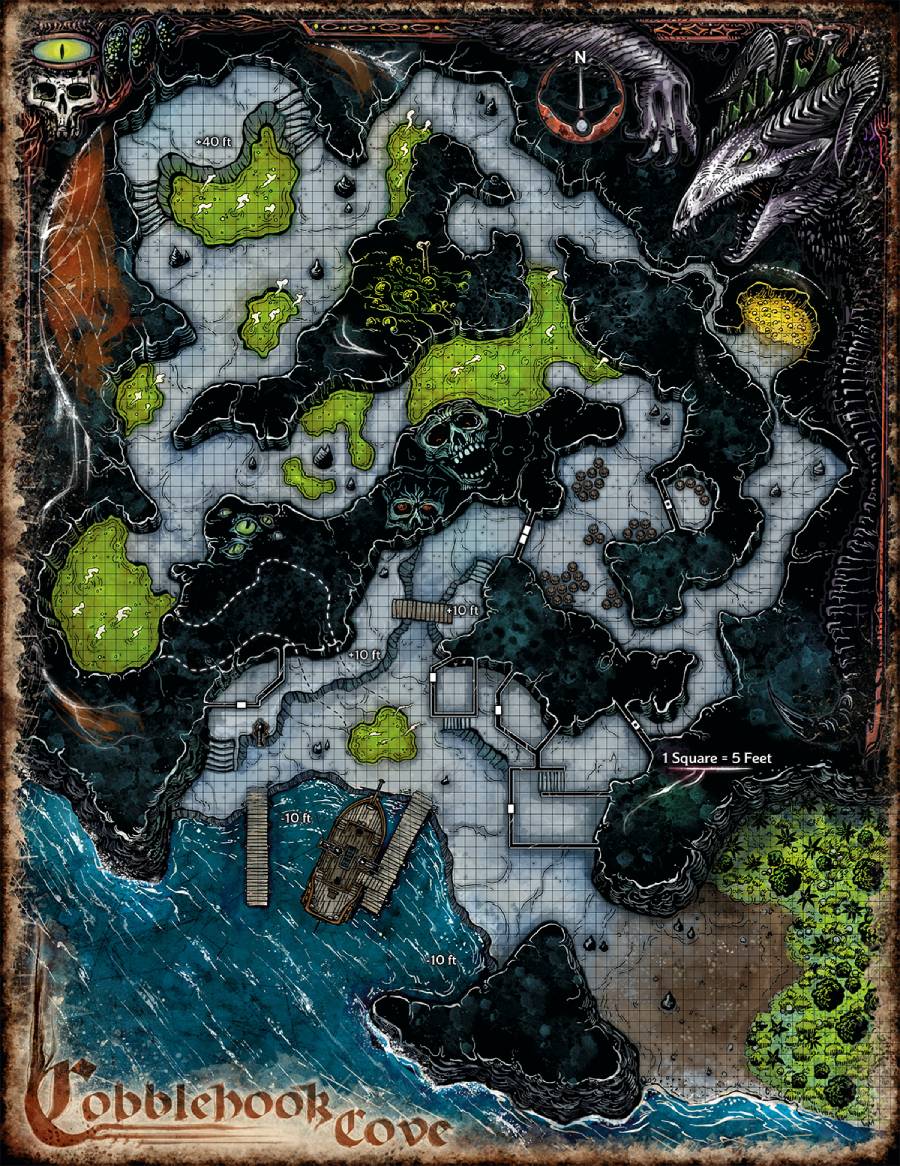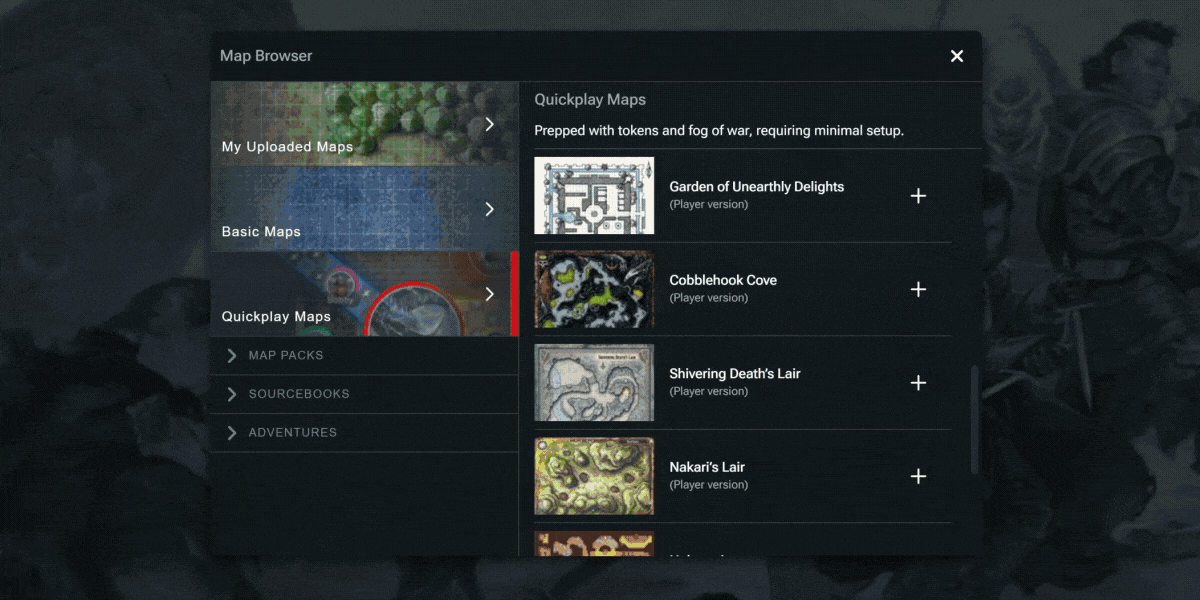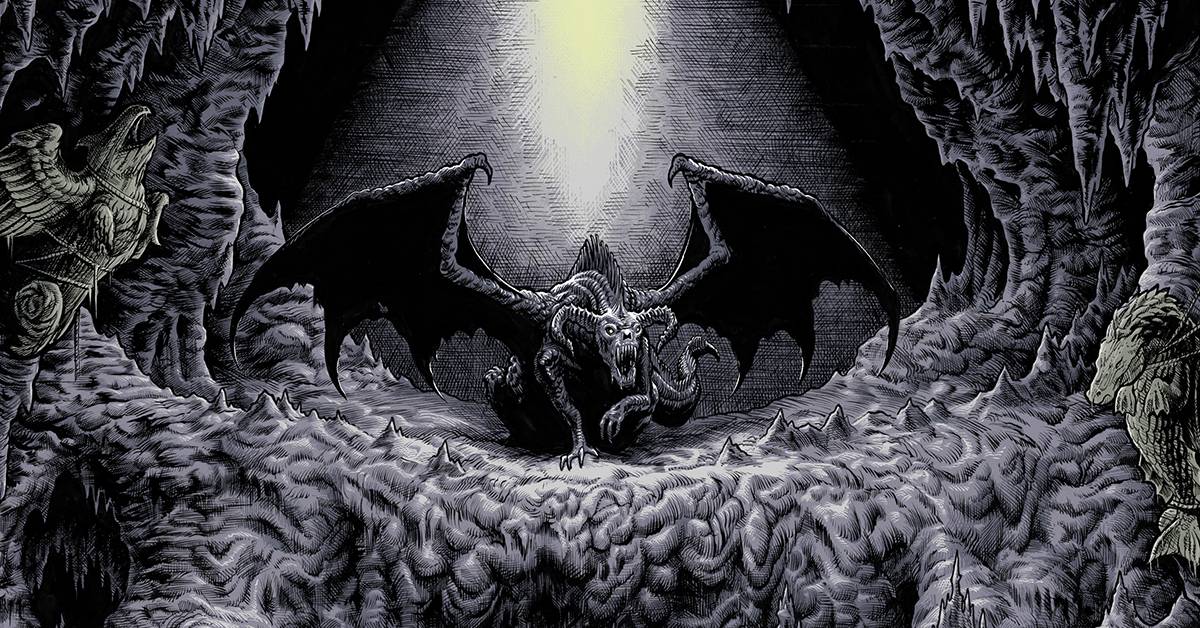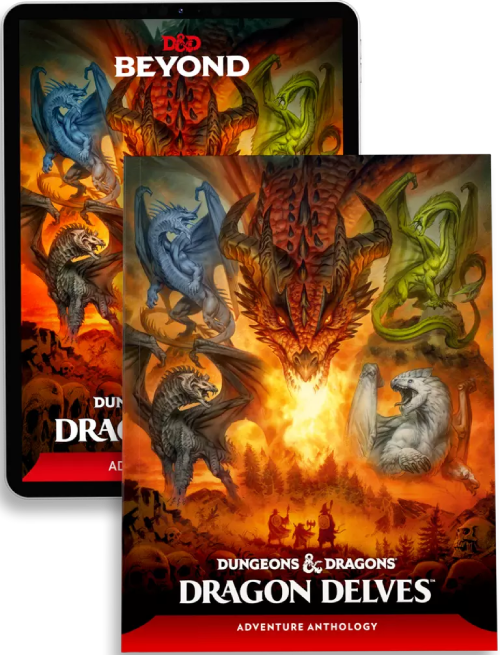From storm-lashed coves to frostbitten caverns, dungeons call intrepid adventurers from every corner of the multiverse to enter in search of danger and reward. In Dragon Delves, you'll find ready-to-use dungeons suitable for characters levels 1 to 12, perfect for when you need a perilous lair ready for tonight's session.
Let’s take a look at how one of the adventures in this collection, Before the Storm, serves as a case study in dungeon design that reflects tips from the Dungeon Master’s Guide and offers inspiration for building your own dungeon that feels alive, dangerous, and unforgettable.
- Start With Your Premise
- Bringing Your Dungeon to Life
- Considering the Dungeon's Flow
- How Monsters Change the Landscape
Your Ultimate Pass to Draconic Adventure
With the Dragon Delves Ultimate Bundle, you'll receive a D&D Beyond digital copy of the book, a physical copy, the exclusive Ancient Gold Dragon Digital Dice Set, and the Dragon Lairs Digital Maps Pack with 5 digital maps and 10 new stickers for all of your dragon-themed adventures.
Start With Your Premise

When creating a dungeon from scratch, you can lean into a classic setup: A red dragon sits atop a treasure trove in a mountain cave, and the adventurers must slay it to claim their loot. Or, you could draw from the wealth of adventure situations provided in the Dungeon Master's Guide to use as a jumping-off point for countless adventures.
Then, there are the weird and wonderful ideas that strike in a moment of inspiration—like, what if a band of brigands suddenly became more violent and ambitious, and what if their coastal hideout was home to more than just the raiding corsairs?
This is the premise of Before the Storm, where the characters will have to venture into the danger of Cobblehook Cove to discover the root cause of the pirates’ increasingly ambitious plundering.
Dungeon Quirks and Storytelling
The Dungeon Master's Guide encourages DMs to give their dungeons personality through dungeon quirks—memorable traits that suggest a site's history or purpose.
Cobblehook Cove is an excellent example of this principle. It wasn't built for the sole purpose of a fight with a boss monster. It serves as a functional staging ground for the Cobblehook Corsairs' operations.
When creating your own dungeon, start by asking: What was this place before, and what is it now? That alone can inspire countless creative details. And if you need more inspiration, the rollable tables in the Dungeon Master's Guide are here to help.
Bringing Your Dungeon to Life

The feeling of delving into a dungeon is always energizing. Your overland travel, however eventful, comes to a close, and now you stand before the precipice: a yawning cave mouth, a crumbling castle, or a sunken ruin lost to time.
But, before you go ahead and stock your dungeons with a bunch of random monsters and call it a day, the Dungeon Master's Guide has advice on how to make your dungeons more than just monster factories with a pile of loot at the end. As long as they are inhabited, even forgotten underground tunnels can have a living, breathing ecology.
Creatures need food, water, and safe spaces. When your dungeon has an internal logic, characters can use it to their advantage. A water source might draw in both prey and predators. Narrow tunnels might limit which creatures can roam. These natural patterns reward observation and create a richer, more believable dungeon.
Cove Sweet Cove
As the pirates' headquarters in Before the Storm, Cobblehook Cove is designed to feel lived in. It features a variety of dungeon rooms that are typical of a hideout, including living quarters, kitchens, guard posts, and vaults. It also has a complex mix of creatures that share the living space.
If you're looking to populate your dungeon with a similar believable, lived-in atmosphere, start by thinking like the creatures that dwell there:
Rooms. Each space should serve a purpose, and the accumulated rooms should serve the basic needs of the inhabitants. You can find additional details for designing dungeon rooms in the Dungeon Master's Guide.
Creatures. The Dungeon Master's Guide suggests perusing the Monster Manual for creatures that match the habitat of your dungeon. If you're looking for further filterability, check out D&D Beyond's Monsters tool, which allows you to filter by habitat, size, creature type, Challenge Rating, and more.
Prep in a Pinch with the Maps VTT
The D&D Beyond digital version of this book also comes with Stickers and 22 play-ready maps for use on the official D&D virtual tabletop, Maps. This allows DMs to generate a digital playspace complete with monster tokens, fog of war, and stickers with a single click!

Considering the Dungeon's Flow
As you creep toward a bend in the corridor, the rumble of voices echoes from the chamber ahead. Clearly, the lair's inhabitants are gathered there. But then, your eye catches a narrow ledge leading to a crack in the stone wall. Could it offer a hidden path deeper into the dungeon? Or does it conceal an even more dangerous route?
The Dungeon Master's Guide suggests that a good dungeon map acts as a flowchart for the adventure. It should provide an environment with plenty of choices and ask the characters, “How do you want to do this?”
When examining the map of Cobblehook Cove, this design philosophy is on full display:
Multiple Approaches. A boisterous Bard might suggest that the party disguise themselves as pirates and infiltrate the ranks. A cunning Rogue might want to take a stealthier approach and slip into the cove from the seaside cave.
Branching Paths. Once the party is inside, the choices branch from there. There is an obvious main route that can be taken, but it will likely be the most heavily patrolled. For keen-eyed or swift-fingered parties, secret passages and locked doors offer easier routes through the hideout.
Unique Terrain. The dungeon is also chock-full of interesting elevation changes, rooms, branching corridors, and hazards. This not only makes exploration exciting, but can also spice up combat if it were to break out.
Secrets to Uncover. Rewarding curiosity with meaningful secrets makes exploration feel exciting and worthwhile. But secrets without purpose can undermine the dungeon's cohesion. When adding hidden passages, stashes, or clues, consider their original function. Were they created to guard treasure or perhaps conceal a traitor's escape route?
How Monsters Change the Landscape

While Cobblehook Cove may have once been a simple smuggler's hideout, a lurking black dragon has twisted the environment to suit their own ends.
The area around the dungeon has been warped by the dragon's presence, causing the land and sea on which the cove rests to become more hostile to unwanted visitors. The region is under the effects of the black dragon's Acrid Haze and Foul Water regional effects, which produce a stifling fog that clings to the terrain and tainted water sources.
Both of these effects make traveling to and navigating the lair more difficult, but that's not all.
The dragon's influence has caused pools of acid to bubble up from beneath the earth, transforming once-harmless caverns into deadly hazards that reshape how the characters must explore and fight.
This is just one example of how a monster can alter the dungeon it inhabits. Similarly, a group of goblins may set up haphazard traps, or a Beholder may create dead magic zones in order to make their lair more defensible.
Tailoring the dungeon to its monstrous inhabitants makes it unique and allows the party to do some research. How might these effects connect to other clues they’ve uncovered? A party can use this thinking to their advantage when it comes time to strategize their approach and navigation of the dungeon.
Don't Want to Build Your Dungeons from Scratch?
With Dragon Delves, you don't have to spend all the time prepping engaging dungeons for your party to crawl through.
Before the Storm is one of ten adventures included in the collection of adventures, many of which feature ready-to-run dungeons themed around a different chromatic or metallic dragon, each with its own flavor, foes, and finale.
Whether you run it as written or use it as a template, these delves are ideal for players who crave exciting exploration and memorable monsters!

Mike Bernier is the founder of Arcane Eye, a site focused on providing useful tips and tricks to all those involved in the world of D&D. Outside of writing for Arcane Eye, Mike spends most of his time playing games, hiking with his partner, and tending the veritable jungle of houseplants that have invaded his house.









-
View User Profile
-
Send Message
Posted Jun 9, 2025Yup, I'm looking forward to this. (First)
-
View User Profile
-
Send Message
Posted Jun 10, 2025This is really interesting, the xandered dungeons, the environmental hazards, and the art is just beautiful. Second
-
View User Profile
-
Send Message
Posted Jun 10, 2025Where's the guy who was commenting that he was going to pass on this book because of the silly cartoony gold dragon art? I want to know how he feels about this one. The art design on that map is off the chain, lol.
Addressing the article: I think one of the reasons old school guys tend to whine that there are no dungeons in D&D anymore is because when you design something with any amount of verisimilitude, it no longer resembles the classic dungeons, which were basically a series of monster closets. I mean, at least that's how I remember them. I would have to make a conscious effort to remind myself that this smuggler hideout is, in fact, a dungeon.
-
View User Profile
-
Send Message
Posted Jun 10, 2025Very good lessons here.